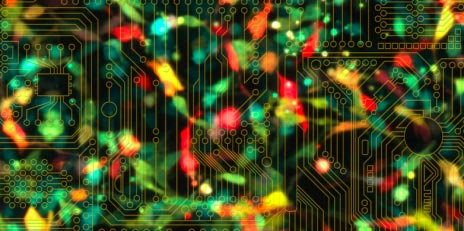Precise and programmable biological circuits

Researchers are expanding the applicability of biological circuits. Background: Microscopic image of human kidney cells with fluorescent proteins in cell culture. (Photo: Montage / iStock)
Bio-engineers are working on the development of biological computers with the aim of designing small circuits made from biological material that can be integrated into cells to change their functions. In the future, such developments could enable cancer cells to be reprogrammed, thereby preventing them from dividing at an uncontrollable rate. Stem cells could likewise be reprogrammed into differentiated organ cells.
The researchers have not progressed that far yet. Although they have spent the past 20 years developing individual components and prototypes of biological computers, bio-computers today still differ significantly from their counterparts made of silicon, and bio-engineers still face several major obstacles.
A silicon chip, for example, computes with ones and zeros – current is either flowing or not – and it can switch between these states in the blink of an eye. In contrast, biological signals are less clear: in addition to ‘signal’ and ‘no signal’, there is a plethora of intermediate states with ‘a little bit of signal’. This is a particular disadvantage for bio-computer components that serve as sensors for specific biomolecules and transmit the relevant signal. Sometimes, they also send an output signal if no input signal is present, and the problem becomes worse when several such components are connected consecutively in a circuit.
ETH doctoral candidate Nicolas Lapique from the group led by Yaakov Benenson, Professor of Synthetic Biology in the Department of Biosystems Science and Engineering at ETH Zurich in Basel, has now developed a biological circuit that controls the activity of individual sensor components using internal “timer”. This circuit prevents a sensor from being active when not required by the system; when required, it can be activated via a control signal. The researchers recently published their work in the scientific journal Nature Chemical Biology.
To understand the underlying technology, it is important to know that these biological sensors consist of synthetic genes that are read by enzymes and converted into RNA and proteins. In the controllable biosensor developed by Lapique, the gene responsible for the output signal is not active in its basic state, as it is installed in the wrong orientation in the circuit DNA. The gene is activated via a special enzyme, a recombinase, which extracts the gene from the circuit DNA and reinstalls it in the correct orientation, making it active. “The input signals can be transmitted much more accurately than before thanks to the precise control over timing in the circuit,” says Benenson.
To date, the researchers have tested the function of their activation-ready sensor in cell culture of human kidney and cancer cells. Nevertheless, they are already looking ahead to further developing the sensor so that it can be used in a more complex bio-computer that detects and kills cancer cells. These bio-computers will be designed to detect typical cancer molecules. If cancer markers are found in a cell, the circuit could, for example, activate a cellular suicide programme. Healthy cells without cancer markers would remain unaffected by this process.
Still, combining various biological components to form more complex bio-computers constitutes a further challenge for bio-engineers. “In electronics, the different components that make up a circuit are always connected in the same way: with a wire through which the current either flows or not,” explains Benenson. In biology, there are a variety of different signals – a host of different proteins or microRNA molecules. In order to combine biologic components in any desired sequence signal converters must be connected between them.
Laura Prochazka, also a doctoral candidate student under Benenson, has developed a versatile signal converter. She published her work recently in the magazine Nature Communications. A special feature of the new component is that not only it converts one signal into another, but it can also be used to convert multiple input signals into multiple output signals in a straightforward manner.
This new biological platform will significantly increase the number of applications for biological circuits. As Benenson says, “The ability to combine biological components at will in a modular, plug-and-play fashion means that we now approach the stage when the concept of programming as we know it from software engineering can be applied to biological computers. Bio-engineers will literally be able to program in future.”
Lapique N, Benenson Y: Digital switching in a biosensor circuit via programmable timing of gene availability. Nature Chemical Biology, online publication 14 October 2014, doi: 10.1038/nchembio.1680
Prochazka L, Angelici B, Häfliger B, Benenson Y: Highly modular bow-tie gene circuits with programmable dynamic behavior, Nature Communications, online publication 14 October 2014, doi: 10.1038/ncomms5729
Media Contact
All latest news from the category: Life Sciences and Chemistry
Articles and reports from the Life Sciences and chemistry area deal with applied and basic research into modern biology, chemistry and human medicine.
Valuable information can be found on a range of life sciences fields including bacteriology, biochemistry, bionics, bioinformatics, biophysics, biotechnology, genetics, geobotany, human biology, marine biology, microbiology, molecular biology, cellular biology, zoology, bioinorganic chemistry, microchemistry and environmental chemistry.
Newest articles

“Nanostitches” enable lighter and tougher composite materials
In research that may lead to next-generation airplanes and spacecraft, MIT engineers used carbon nanotubes to prevent cracking in multilayered composites. To save on fuel and reduce aircraft emissions, engineers…

Trash to treasure
Researchers turn metal waste into catalyst for hydrogen. Scientists have found a way to transform metal waste into a highly efficient catalyst to make hydrogen from water, a discovery that…

Real-time detection of infectious disease viruses
… by searching for molecular fingerprinting. A research team consisting of Professor Kyoung-Duck Park and Taeyoung Moon and Huitae Joo, PhD candidates, from the Department of Physics at Pohang University…





















